The DVS once again visits new viola frontiers! This time our intrepid reporter Karin Dolman is reporting from the very First Oskar Nedbal International Viola Competition in Prague (Oct 31st – Nov 3rd, 2019).
Sunday morning – time for the 2nd (and final) round of this competition. The twelve finalists selected yesterday will play in the same relative order as they appeared in the 1st round (which was, by the way, alphabetical by last name).
The 2nd round repertoire consists of:
– Oskar Nedbal: Romantic piece op.18
– A sonata for Viola and Piano: Choice of Martinů, Hindemith (op.11/4), Clarke, Brahms (op.120 either one), Schubert (Arpeggione), Paganini, Feld, Reger, Vieuxtemps, or Kalabis
To remind you what’s at stake here:
1st prize – 20000 Czech Crowns (= €780), a fine bow, viola case and various accessories
2nd prize – 15000 Czech Crowns (= €590), viola case and various accessories
3rd prize – 10000 Czech Crowns (= €390), viola case and various accessories
In addition there are smaller cash prizes for the best interpretation of the Oskar Nedbal piece, the Martinu and Kalabis sonatas, and various other concert and masterclass prizes.
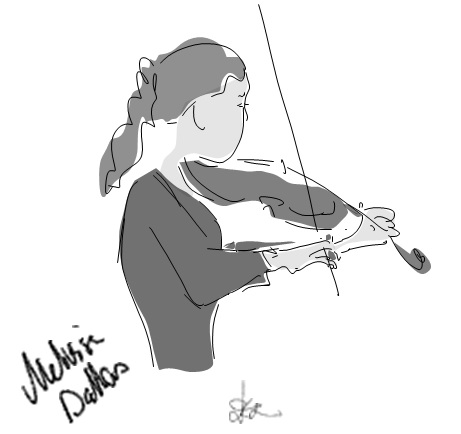 The first candidate is Melissa Datta. She chose the Rebecca Clarke sonata, with which she presents a fiery start. The solo opening sentence of this piece really determines the character of the performance, and tells a lot about the musician. The next challenge is to keep the ensuing impressionistic part interesting, Melissa does that well. The 2nd movement is a scherzo with lots of humour (a familiar trait from Clarke’s other compositions). In the 3rd movement, we should be awash in all the love of the world. I feel that Melissa comes up a bit short in that respect, radiating above all bravura. She seems to be also a bit unfamiliar with the piano accompaniment.
The first candidate is Melissa Datta. She chose the Rebecca Clarke sonata, with which she presents a fiery start. The solo opening sentence of this piece really determines the character of the performance, and tells a lot about the musician. The next challenge is to keep the ensuing impressionistic part interesting, Melissa does that well. The 2nd movement is a scherzo with lots of humour (a familiar trait from Clarke’s other compositions). In the 3rd movement, we should be awash in all the love of the world. I feel that Melissa comes up a bit short in that respect, radiating above all bravura. She seems to be also a bit unfamiliar with the piano accompaniment.
She goes on to provide my first encounter with the Oskar Nedbal piece, which offers a lot of room to provide different interpretations.
 The second candidate is Nicolas Garrigues, bringing his Martinu sonata to the Lion’s den, thereby shooting for the special Martinu prize. He starts off passionately on this sonata, which contains a treacherous field of syncopations. But therein lies also the musical power of this piece. However I miss the balance between piano and viola; Nicolas knows the piece well enough, playing large segments by heart, but does not capitalize on this advantage to communicate and connect musically with the pianist, turning instead toward the audience to project even more sound from his viola, which is really already loud enough. I miss also the multitude of colours and moods that are latent in the score of this piece.
The second candidate is Nicolas Garrigues, bringing his Martinu sonata to the Lion’s den, thereby shooting for the special Martinu prize. He starts off passionately on this sonata, which contains a treacherous field of syncopations. But therein lies also the musical power of this piece. However I miss the balance between piano and viola; Nicolas knows the piece well enough, playing large segments by heart, but does not capitalize on this advantage to communicate and connect musically with the pianist, turning instead toward the audience to project even more sound from his viola, which is really already loud enough. I miss also the multitude of colours and moods that are latent in the score of this piece.
The Nedbal piece, too, is performed by heart. The rhythmic figures could have been rendered more clearly, but I trust that is his conscious choice of interpretation, this is only the 2nd time I hear the piece. The recapitulation of the main theme with a muted viola (and a more elaborate piano part): would it work better if shifted one octave up? My imagination starts to work on this.
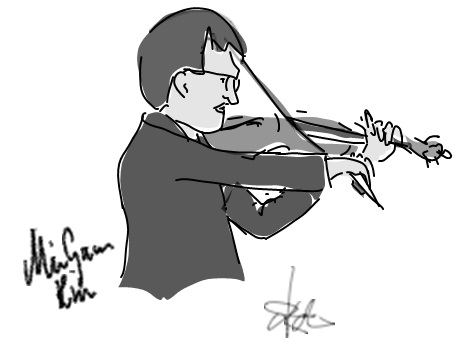 The South Korean MinGwan Kim starts with Nedbal. His vibrato and playing style is perfect for this piece, including his masterful use of portato. The scherzo segment brings the proper humouristic flair.
The South Korean MinGwan Kim starts with Nedbal. His vibrato and playing style is perfect for this piece, including his masterful use of portato. The scherzo segment brings the proper humouristic flair.
And then, what a beautiful Vieuxtemps sonata, romantic and yet precise. Like his predecessor, MinGwan largely stands averted from the pianist, but he manages to communicate through his back and neck. He knows exactly where the pianist is, their togetherness is stunning – although they probably have only had one rehearsal together.
In the beautiful Barcarolle movement, MinGwan tastefully makes use of the potential rubato moments. This movement is so good, and it could easily be performed as a self-standing piece. I could compare it to Shakespeare’s Ophelia, who has taken on a life of her own outside of the original play Hamlet, inspiring artists in many fields. Having a distinctive title (“barcarolle”) helps a bit in this sense. The third movement comes with the indication con molto delicatezza, and transitions into the fiery finale.
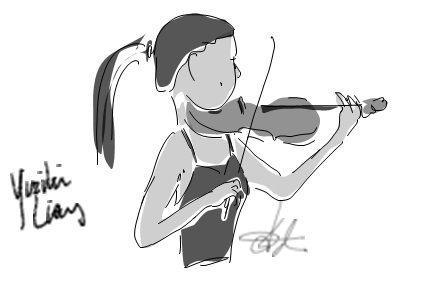 On to the fourth candidate, Yizilin Liang, who starts off with a romantic rendition of Nedbal, played by heart. Her interpretation of Hindemith (11.4) however misses the flexibility and contrasts demanded by the composer’s variations – it becomes a bit monotonous. Her communication with the pianist is very good.
On to the fourth candidate, Yizilin Liang, who starts off with a romantic rendition of Nedbal, played by heart. Her interpretation of Hindemith (11.4) however misses the flexibility and contrasts demanded by the composer’s variations – it becomes a bit monotonous. Her communication with the pianist is very good.
 Why do I have to think of Woody Allen when I see Amir Liberson on stage? Maybe due to his surprisingly fast and at times funny movements. At times I find this goes at the expense of his playing, such as in the Nedbal (performed by heart). At other times, this body language enhances the character of the music, so it isn’t all bad. And he communicates well with the pianist.
Why do I have to think of Woody Allen when I see Amir Liberson on stage? Maybe due to his surprisingly fast and at times funny movements. At times I find this goes at the expense of his playing, such as in the Nedbal (performed by heart). At other times, this body language enhances the character of the music, so it isn’t all bad. And he communicates well with the pianist.
His Brahms sonata is unfortunately tainted by local intonation issues – this challenge is often underestimated in Brahms (not only the viola sonatas), composed in awkward keys with a risk of high intonation.
 The lone Czech candidate in the final round, Daniël Macho also plays the Romantic Piece by heart. While he is visibly nervous, nothing catastrophic happens. But in the Martinu sonata, which should be a perfect fit for him, it turns out he’s not sufficiently in sync with the piano score
The lone Czech candidate in the final round, Daniël Macho also plays the Romantic Piece by heart. While he is visibly nervous, nothing catastrophic happens. But in the Martinu sonata, which should be a perfect fit for him, it turns out he’s not sufficiently in sync with the piano score
 Polish finalist Julia Palecka plays the Schubert Arpeggione sonata. This piece is in my mind a parade of personalities from an Opera Buffa. But Julia’s personality as I sensed it in the 1st round does not return in full in this 2nd round. Perhaps a mature Schubert needs more time. The last movement leans more on technique, and that works out OK for Julia. She flies elegently through this movement, and perhaps owing to her feeling technical confidence here, I also sense more of the humour between the lines.
Polish finalist Julia Palecka plays the Schubert Arpeggione sonata. This piece is in my mind a parade of personalities from an Opera Buffa. But Julia’s personality as I sensed it in the 1st round does not return in full in this 2nd round. Perhaps a mature Schubert needs more time. The last movement leans more on technique, and that works out OK for Julia. She flies elegently through this movement, and perhaps owing to her feeling technical confidence here, I also sense more of the humour between the lines.
In the Nedbal piece, Julia creates much more freedom, playing by heart and communicating with the audience – even getting response back. Nice ending!
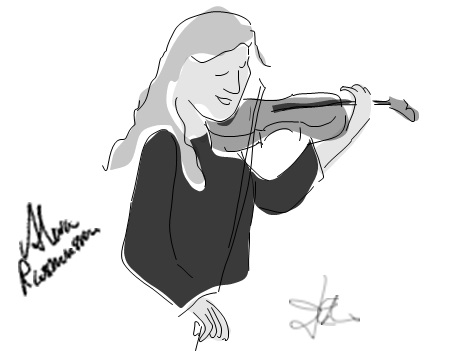 The Swedish Alva Rasmussen, studying with one of the jury members in Copenhagen, makes an impressive entree with a high-grade Rebecca Clarke; I’d like to think that the composer very much enjoys this performance from her cloud up there! She runs light-footed like a deer through the scherzo, and lavishes us with a wonderful warm vibrato in the opening of the 3rd movement. I get carried away in her dream. Nice use of poco vibrato in the thin high-octave melody, followed by a return to portamenti and a large warm vibrato in the lower strings. Her love for this sonata really shines through!
The Swedish Alva Rasmussen, studying with one of the jury members in Copenhagen, makes an impressive entree with a high-grade Rebecca Clarke; I’d like to think that the composer very much enjoys this performance from her cloud up there! She runs light-footed like a deer through the scherzo, and lavishes us with a wonderful warm vibrato in the opening of the 3rd movement. I get carried away in her dream. Nice use of poco vibrato in the thin high-octave melody, followed by a return to portamenti and a large warm vibrato in the lower strings. Her love for this sonata really shines through!
Alva seems to have an old soul. You seem to hear a whole lifetime’s worth of loves, joys, and sorrows in her playing. She also plays a marvellous Nedbal.
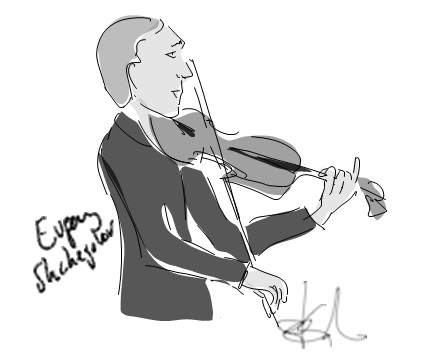 Evgeny Shchegolev also knows how to play a good and warm Nedbal. Now I can hear his powerful Russian tone. This romantic music is really his domain. In the 1st round, I didn’t mention him in my summary (he played Bach and Henze), but here he is on good terms with the music. In the Brahms sonata he knows how to stretch the bars and to knead the melodies plastically – highly enjoyable!
Evgeny Shchegolev also knows how to play a good and warm Nedbal. Now I can hear his powerful Russian tone. This romantic music is really his domain. In the 1st round, I didn’t mention him in my summary (he played Bach and Henze), but here he is on good terms with the music. In the Brahms sonata he knows how to stretch the bars and to knead the melodies plastically – highly enjoyable!
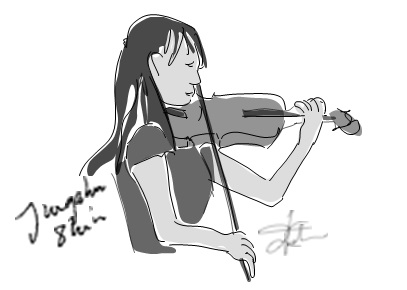 The 20-year-old Jungahn Shin starts with a marvellous Brahms sonata (in F). I find especially her rendition of the 2nd movement deeply touching, with a beautiful tone. The Waltz too (3rd movement) – wait, wasn’t she the Tabea Zimmermann pupil? Yes – but she still has her very own sound. Compared to this, I’m very curious to hear what our Dutch students will make of the Brahms F-sonata (mandatory piece) at the National Viola Competition next week!
The 20-year-old Jungahn Shin starts with a marvellous Brahms sonata (in F). I find especially her rendition of the 2nd movement deeply touching, with a beautiful tone. The Waltz too (3rd movement) – wait, wasn’t she the Tabea Zimmermann pupil? Yes – but she still has her very own sound. Compared to this, I’m very curious to hear what our Dutch students will make of the Brahms F-sonata (mandatory piece) at the National Viola Competition next week!
Jungahn concludes her recital with the Nedbal Romantic piece. In this rendition, I miss the broad vibrato which seems to fit this piece so well.
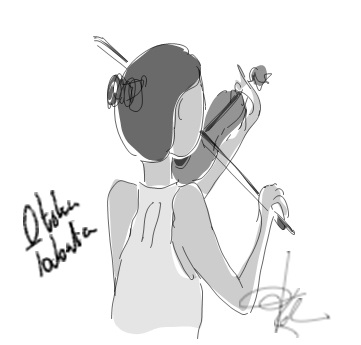 The Japanese Otoha Tabata is a true storyteller. Like the fabled princess Sheherazade, she enchants you and does not let go. She is agile and moves about, but not in a disturbing way. It makes it difficult to draw her, though. If I may complain a little bit, I might like to suggest some fingerings in the higher positions, to allow more variation in colour. Especially in the 2nd movement of Brahms. The jury will have a hard time: Four Brahms renditions, all different and with their own characters.
The Japanese Otoha Tabata is a true storyteller. Like the fabled princess Sheherazade, she enchants you and does not let go. She is agile and moves about, but not in a disturbing way. It makes it difficult to draw her, though. If I may complain a little bit, I might like to suggest some fingerings in the higher positions, to allow more variation in colour. Especially in the 2nd movement of Brahms. The jury will have a hard time: Four Brahms renditions, all different and with their own characters.
Although Otoha naturally tends toward a somewhat fast vibrato, she adapts it totally in the Nedbal piece. The tempo is nice and fresh, it sounds almost like an early recording. She makes her performance a feast for ears and eyes, including that beautiful smile when she takes a bow.
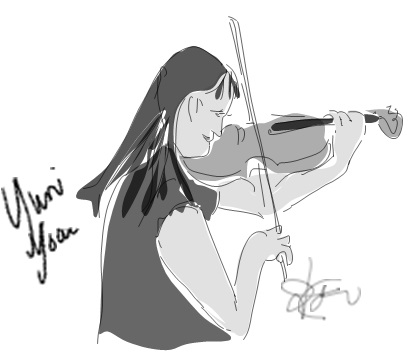 The last candidate (yet again – I bet she curses the latin alphabet now and then!) is Yuri Yoon. She, too, plays a very good Nedbal. But the true spectacle comes with the Vieuxtemps sonata: Starting out with a zesty tempo, yet every note precise and pitch perfect. Even going out of her way to keep the pianist on track, she plays a fantastic 1st movement.
The last candidate (yet again – I bet she curses the latin alphabet now and then!) is Yuri Yoon. She, too, plays a very good Nedbal. But the true spectacle comes with the Vieuxtemps sonata: Starting out with a zesty tempo, yet every note precise and pitch perfect. Even going out of her way to keep the pianist on track, she plays a fantastic 1st movement.
The Barcarolle (2nd mvt.) also holds a relatively fast tempo, whereby the rubato passages stand more out in contrast. But I miss a different sound here, it is rather too sharp, where I’ve come to feel a more “granular” sound would be nicer.
… Well, this concludes my “live” competition coverage – I have to leave to catch my train home, so I will miss the (live) results announcement and the laureates’ concert this evening. But through the internet, I learned that the competition results were as follows:
1st prize: MinGwan Kim (South Korea)
2nd prize: Yuri Yoon (South Korea)
3rd prize: Evgeny Shchegloev (Russia)
Honorary mention:
Yizilin Liang (China), Alva Rasmussen (Sweden) and Otoha Tabata (Japan)

Nedbal Competition 2019 main Prize winners Yoon, Kim, and Shchegolev (photo credits: Zdeněk Chrapek, Oskar Nedbal competition)
Congratulations to all!
Karin
